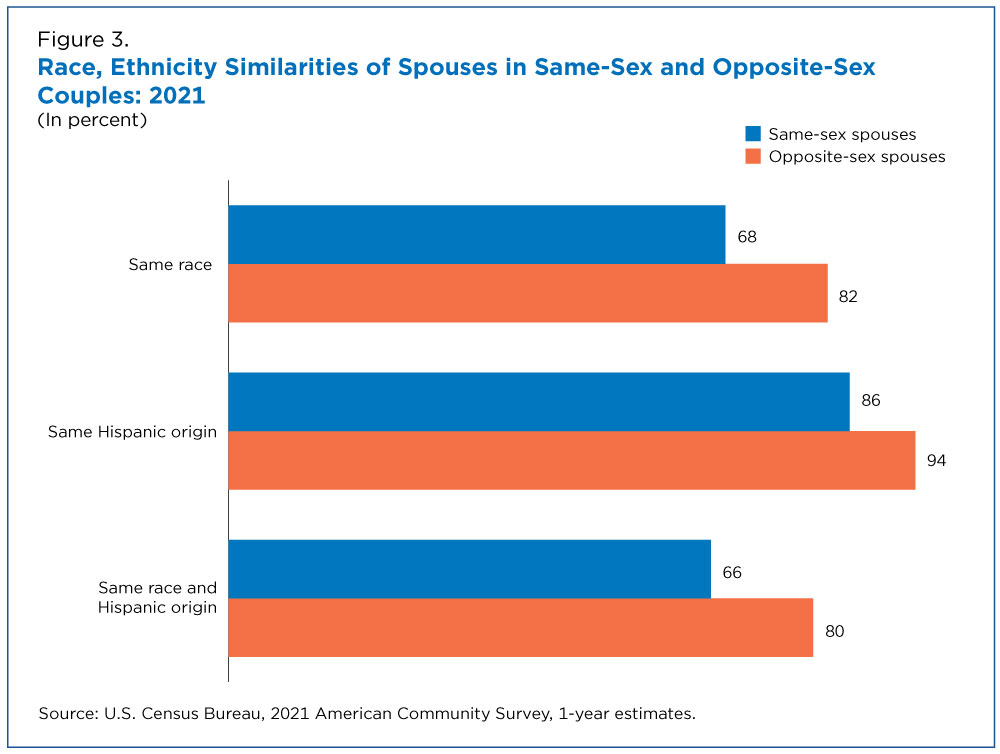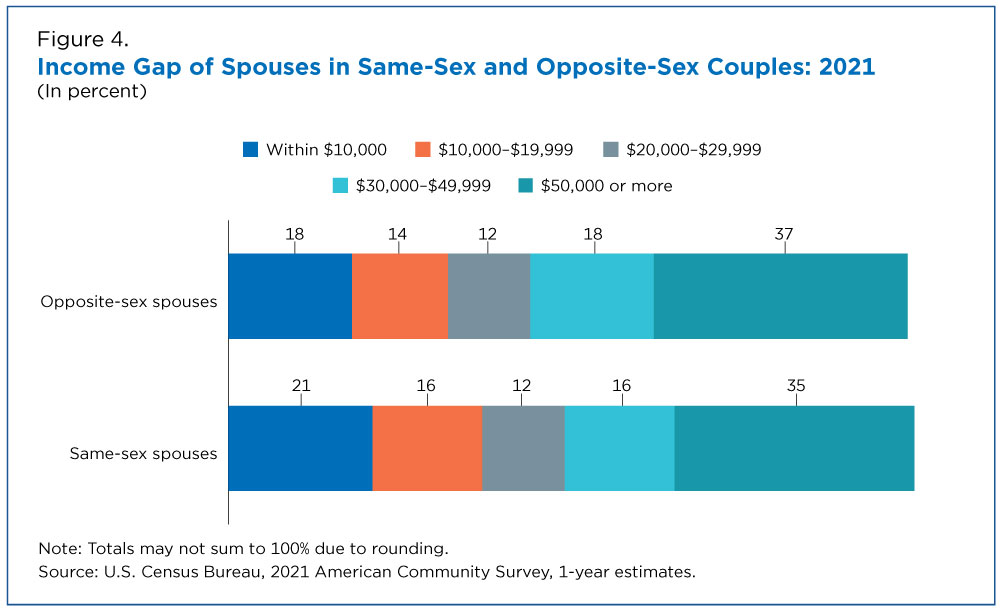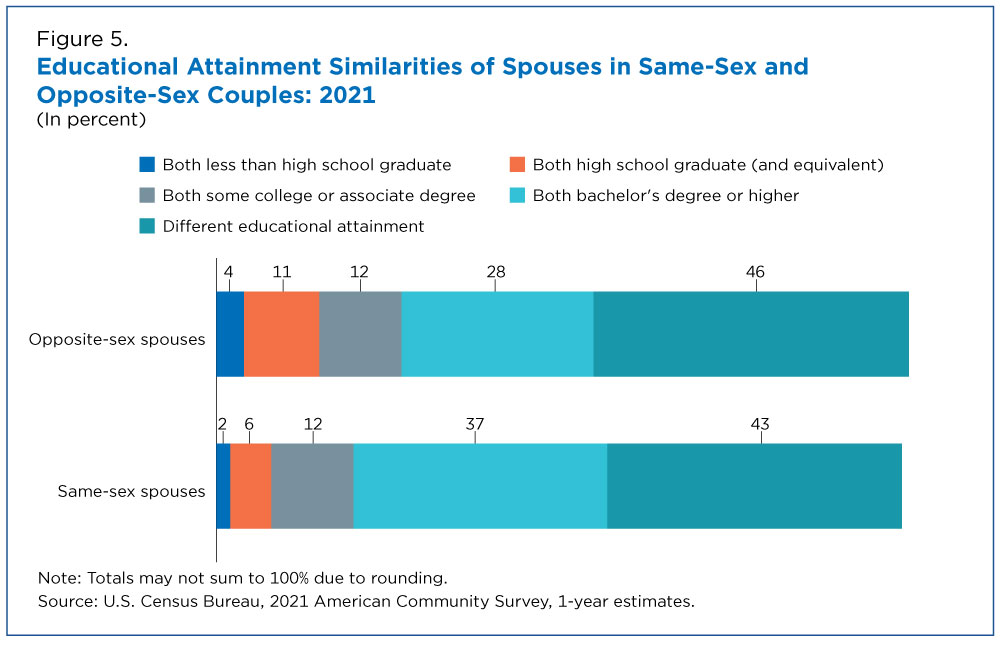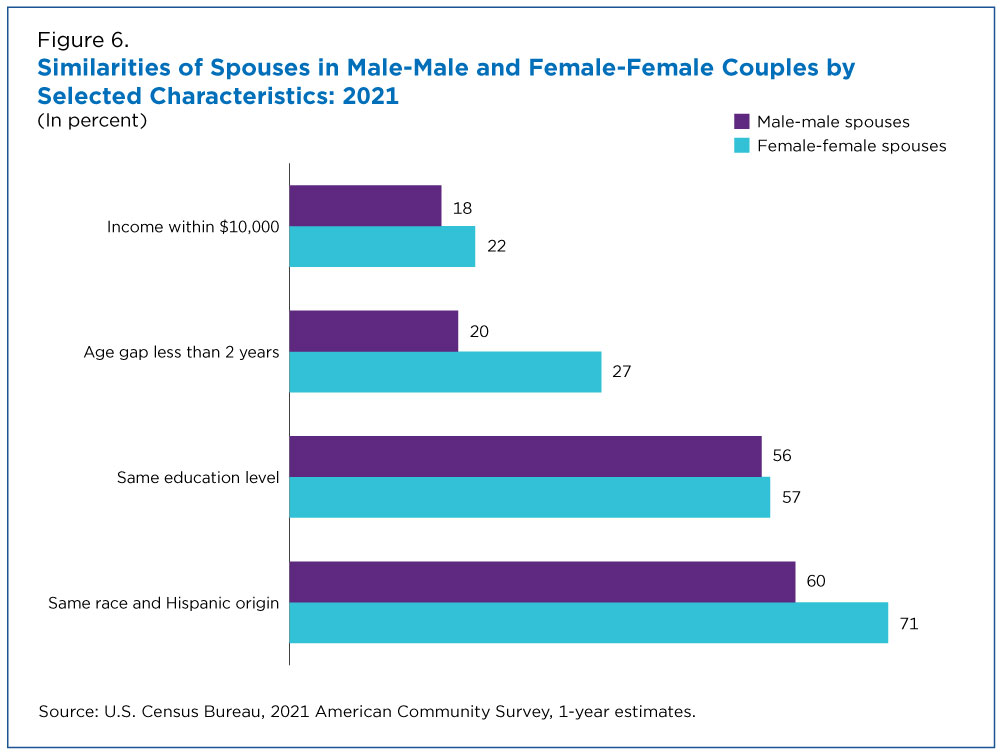Same-Sex Male Spouses Less Similar than Female-Female Spouses
Same-sex married couples are less likely than opposite-sex married couples to have spouses who are the same age and the same race and Hispanic origin, according to the 2021 1-year American Community Survey.
In contrast, same-sex spouses were more likely than opposite-sex spouses to have similar income and education levels.
On average, married couples share more characteristics — such as race and ethnicity, income, and age — than expected by chance. Known as homogamy, it’s the concept that people tend to marry those with characteristics similar to their own.
A previous study of homogamy using decennial data from 1990 and 2000 — before same-sex marriage was legalized in the United States — found that same-sex male cohabiters were the least likely pairing to be homogamous and that opposite-sex married couples were the most likely.
Among those in opposite-sex marriages, 82% had a spouse of the same race compared to 68% of those in same-sex marriages.
This article provides updated estimates on patterns of similarity between spouses in 2021. Due to data limitations, this analysis only covers married couples that include the householder. More information on the characteristics of same-sex couple households is available.
Those in opposite-sex marriages were more likely than those in same-sex marriages to have a spouse with similar social characteristics (age and race/Hispanic origin) (Figure 1).
In 80% of opposite-sex married couples, the spouses were the same race and Hispanic origin compared to only 66% of same-sex married couples.
Similarly, 35% of adults in opposite-sex marriages had spouses less than two years of age apart compared to 24% of those in same-sex married couples.
Spouses in same-sex married couples were more likely to have similar economic characteristics (income and education level) than opposite-sex spouses.
About 21% of same-sex and 18% of opposite-sex couples had spouses with incomes within $10,000 of one another (income for individuals includes eight types of income defined here. It is based on the time of interview even though the amounts are for the past 12 months).
A greater share (57%) of same-sex than opposite-sex (54%) spouses also had the same education level.
Age and Race Similarities of Spouses
Distributions of age (Figure 2) and race and Hispanic origin (Figure 3) for opposite- and same-sex spouses revealed a few key differences.
Among them: As noted above, spouses in opposite-sex marriages were more likely than those in same-sex marriages to be close (within in two years) in age.
Conversely, same-sex spouses were more likely to have larger age differences — 5% had age gaps of 20 years or more compared to 1% of opposite-sex spouses.
Among those in opposite-sex marriages, 82% had a spouse of the same race compared to 68% of those in same-sex marriages. Opposite-sex marriages were also more likely than same-sex marriages to include spouses with the same Hispanic origin.
Combining race and Hispanic origin status reveals the same pattern: 80% of opposite-sex married couples involved spouses who share race and Hispanic origin, whereas two-thirds (66%) of same-sex couples did so.
Economic Similarities of Spouses
Same-sex spouses (21%) were more likely than their opposite-sex counterparts (18%) to earn within $10,000 annually of one another. Meanwhile, opposite-sex spouses were more likely to have income gaps of $50,000 or more (37% compared to 35%) (Figure 4). It should be noted that spousal income gaps may be more meaningful when one or both spouses were at the lower end of the economic spectrum.
Across education levels, it was more likely for both spouses in same-sex marriages to have at least a bachelor’s degree, while it was more likely for opposite-sex married couples to both have a high school education as their highest level of educational attainment (Figure 5).
Similarities of Same-Sex Male and Female Spouses
Men in same-sex marriages were less similar than women in same-sex marriages for all characteristics except educational attainment (Figure 6).
As a result, among all possible marriage pairings, men in same-sex marriages were the least likely to have a spouse with similar characteristics.
In 2021, spouses in female-female marriages (22%) were more likely than those in male-male marriages (18%) to have annual incomes within $10,000 of their spouses' incomes.
Similarly, female-female married couples (27%) were more likely than male-male married couples (20%) to include spouses with less than a two year age gap.
Finally, the data show that in 2021, 60% of same-sex male married couples included spouses of the same race and Hispanic origin compared to 71% of female-female couples.
About the Data
The American Community Survey collects annual data on living arrangements, including marital status and the relationship between householders and the other household members. Further information about changes in ways the Census Bureau collects information about same-sex couples over time is available.
Related Statistics
Stats for Stories
Stats for Stories
Subscribe
Our email newsletter is sent out on the day we publish a story. Get an alert directly in your inbox to read, share and blog about our newest stories.
Contact our Public Information Office for media inquiries or interviews.












